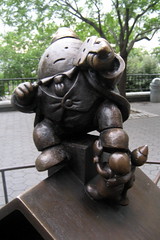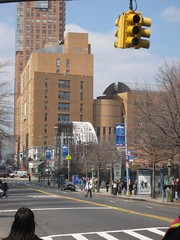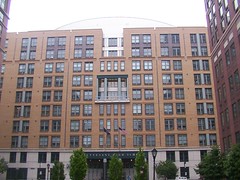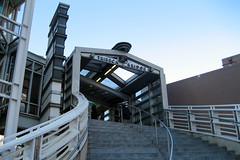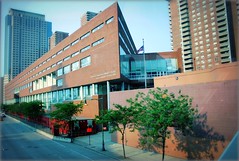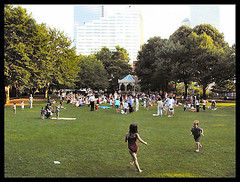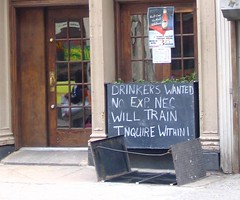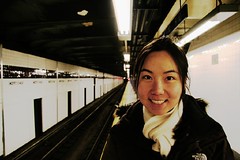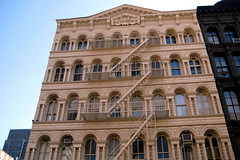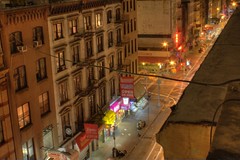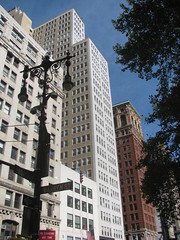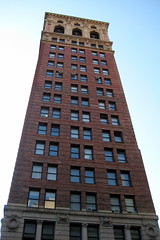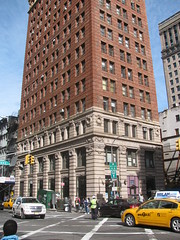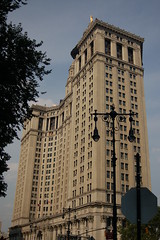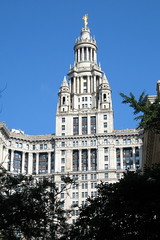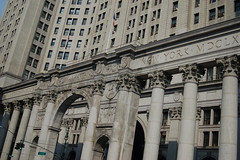South:
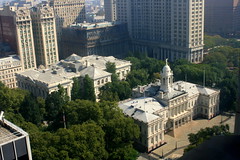
This was originally set aside in 1686 by the Dutch
colonial government as The Commons, a pasture
adjacent to the Collect Pond where townsfolk
could take their livestock to eat and drink.
It soon became the city's main park, serving as a gathering place
for celebrations--and protests.
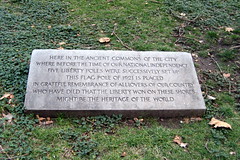
On August 11, 1766, New Yorkers angry that their Liberty
Pole protest in the park had been taken down, threw bricks
at British soldiers here, who retaliated with
bayonets--resulting in the first (non-fatal) bloodshed of
the Revolutionary era. General George Washington
had the Declaration of Independence read here
on July 9, 1776.
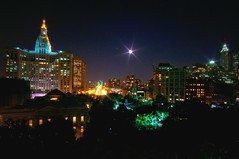
In 1826, African-Americans rioted here
against slave-catchers pursuing escapees
from the South. Another riot here in 1837 opposed
the price of flour rising from
$6 to $15 a barrel. Blacks were attacked
here during the Draft Riots of 1863.
When Albany in 1857 replaced the corrupt
Municipal Police with a new organization known as
the Metropolitan Police, the two forces clashed
here in a
melee that left one officer permanently
crippled. Closer to the present, police
rioted here in September 1992 against Mayor David Dinkins'
Civilian Complaint Review Board proposals.
When author
Jack London was homeless for a time,
he spent his nights in City Hall Park--
a time that inspired his novel The
People of the Abyss.

52: Built between 1861 and 1871, this former
Criminal Courts Building was supposed to cost
$250,000; it ended up costing as much as $14 million,
with much of the difference being pocketed by William
''Boss'' Tweed and his Tammany Hall cronies.
 This
graft, excessive even for those days, helped land
Tweed in jail, but it is a remarkably beautiful
building.
This
graft, excessive even for those days, helped land
Tweed in jail, but it is a remarkably beautiful
building.
This site was earlier the New York Institution, the
city's almshouse; the residents were transferred to
Bellevue in 1816, after which the building served to house
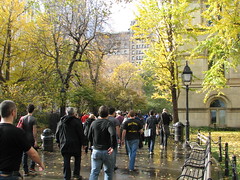 the New-York Historical Society, the Society Library,
the American Academy of Fine Arts and the Bank for Savings.
the New-York Historical Society, the Society Library,
the American Academy of Fine Arts and the Bank for Savings.
Corner: In 1818, The Rotunda was built here,
an art gallery backed by Aaron Burr that featured under
its central dome a panoramic painting of the Garden of
Versailles (which can now be seen in the Metropolitan
Museum of Art). The enterprise was a commercial failure, and
the temple-like building housed city government offices
until it was destroyed in 1870.
|
|
|
North:
Sun Building
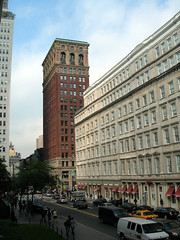
Corner (274 Broadway): New York State Office Building,
which houses the city's Buildings department,
was built by A.T. Stewart in 1846 for the
the world's first true department store, known as
the Marble Palace.
The building's marble-clad Italianate design inspired
hundreds of other commercial buildings.
Later used (1919-50) as the offices
of the New York Sun, a newspaper best remembered
for its 1897 "Yes, Virginia" editorial and for the
1835
Great Moon Hoax.
 It was Sun editor John B. Bogart
who said, in 1882, "When a dog bites a man that is
not news, but when a man bites a dog that is news."
It was Sun editor John B. Bogart
who said, in 1882, "When a dog bites a man that is
not news, but when a man bites a dog that is news."
The paper's clocks, with the motto
"The Sun--It Shines for All," are still on the building's
corners.
Built on site of the Washington Hotel (1812), which served as
the Federalist Party HQ.
49 (corner): This building, topped with eagles
and globes, was the Emigrant Industrial Savings Bank (1908).
It now houses city offices,
including the Board of Correction, the Council on
Environment, the Department of Investigation
and the New York City Rent Guidelines Board.
39-41: The address of Palmo's Opera House,
which opened in 1844 to bring Italian opera to New York; it closed
two years later, reopening as Burton's Chamber Street Theater,
whose offerings included "artist model shows" that featured
nearly nude men and women. Burton's was the first theater
in the city to sell tickets for particular seats.
|
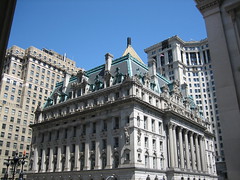
31 (block): This Beaux Arts masterpiece,
designed by John R. Thomas, was built between 1899
and 1907 at a cost of more than $7 million. It was originally
known as the Hall of Records, but it's always been
home to the Surrogate's Court, which handles wills,
estates and adoptions.
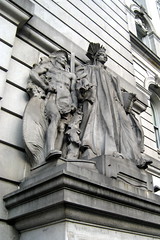
Flanking the entrance are Philip Martiny's allegorical
figures representing
Law and
Philosophy.
Justice
and
Authority used to be represented on the Centre Street
side, but they were removed to the New York County Courthouse
when that roadway was widened in 1961.

The facade also features Martiny's statues of historical figures
connected with New York and New Amsterdam, many of them
now obscure: From left, they are
David Pietersen de Vries,
Caleb Heathcote,
DeWitt Clinton, Abram S. Hewitt, Philip Hone, Peter Stuyvesant,
Cadwallader D. Colden and
James Duane.

The gorgeous interior was inspired by the Paris
Opera House, whose influence can also be seen on
Grand Central Terminal.
This was where Nicole Kidman worked in Batman Forever,
Keanu Reeves did some lawyering in Devil's Advocate
and Gary Oldman met his fate in Romeo Is Bleeding.
Built in 1799 on this site was the Manhattan Company Reservoir,
the holding tank for Aaron Burr's water company, designed
in an Egyptian style with a statue of Aquarius the water-bearer.
Burr had started the company because it was easier for an
existing company to go into banking than to get
a new bank chartered; the bank that he got going through
this gambit eventually put the "Manhattan" in Chase Manhattan. Alexander
Hamilton's objections to this roundabout creation of a competitor
to Hamilton's Bank Of New York sparked a feud that eventually
culminated in the fatal Burr/Hamilton duel of 1804.
|
|
 A 92-acre planned neighborhood built on landfill from the construction
of the World Trade Center. Based on a 1979 master plan that tied the
new area into the existing Manhattan grid, the result is one of Manhattan's most
appealing and livable examples of modern urban development.
A 92-acre planned neighborhood built on landfill from the construction
of the World Trade Center. Based on a 1979 master plan that tied the
new area into the existing Manhattan grid, the result is one of Manhattan's most
appealing and livable examples of modern urban development.

